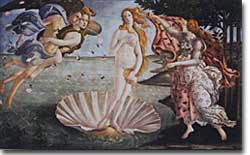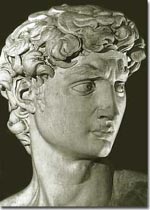|
LINKS |
The Renaissance
For many historians, the Renaissance, which began in Northern Italy in the 1300s, marked the rebirth of civilization in Europe. In fact, the Renaissance is often viewed as the beginning of modern history, for it was during this time that many of the characteristics of contemporary western society developed. Most modern western values trace their roots back to trends that evolved during the Italian Renaissance. These values range from the way people think to the way people earn a living both in the United States and in Europe.
The term "Renaissance," which literally means "rebirth," was given to the movement that began in Northern Italy in the 1300s, spread across Europe, and culminated in the 1500s. The Renaissance followed the Middle Ages (500-1300), which were incorrectly characterized as a period of darkness, ignorance, and barbarism. In reality, many of the societal changes that occurred during the Renaissance began during the later Middle Ages. Prior to the Middle Ages, the ancient civilizations of Greece and Rome dominated Europe. It was the classical culture of Ancient Greece and Rome that Europeans saw being reborn in the Renaissance. Perhaps the most obvious area of rebirth during the Renaissance occurred in the field of the arts. It is during this time that new techniques in painting, sculpture, and architecture produced some of the greatest works the world has ever seen. Also, new ideas combined with revived old ideas to produce significant written works in many intellectual fields — politics, religion, history, society, etc. These works reflected the unlimited potential of humans and sought to celebrate humanity in its many forms.
This new view of humans that developed during the Renaissance can best be summed by the phrase "Man is the measure of all things." In the Middle Ages, God, as defined by the Catholic Church, was the measure of all things. All aspects of medieval life revolved around God and the Church. During the Renaissance, people's focus began to shift to the here and now on earth, rather than the hereafter in heaven. This new attitude would trigger a centuries-long conflict between the existing religious order and the emerging secular, material order. Ultimately, at the root of many of these changes was economic change. This rebirth in "civilization" coincides with a gradual shift from an agricultural economy to a commercial economy built on trade. The medieval feudal system, a rigid agricultural hierarchy, succeeded in bringing stability to Europe. However, this stability allowed the Renaissance commercial economy to flourish. Ironically, this burgeoning economic system that would eventually culminate in capitalism would eliminate the feudal system that helped create it. |
|||||
| The High Renaissance | ||||||
| Renaissance Literature | ||||||
| Daily Life | ||||||


